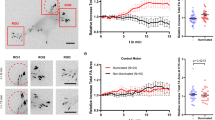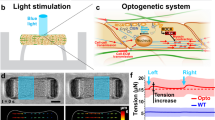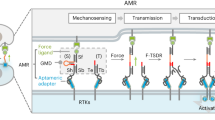Abstract
To control receptor tension optically at the cell surface, we developed an approach involving optomechanical actuator nanoparticles that are controlled with near-infrared light. Illumination leads to particle collapse, delivering piconewton forces to specific cell surface receptors with high spatial and temporal resolution. We demonstrate optomechanical actuation by controlling integrin-based focal adhesion formation, cell protrusion and migration, and T cell receptor activation.
This is a preview of subscription content, access via your institution
Access options
Subscribe to this journal
Receive 12 print issues and online access
$259.00 per year
only $21.58 per issue
Buy this article
- Purchase on Springer Link
- Instant access to full article PDF
Prices may be subject to local taxes which are calculated during checkout



Similar content being viewed by others
References
Vogel, V. & Sheetz, M. Nat. Rev. Mol. Cell Biol. 7, 265–275 (2006).
Dufrêne, Y.F. et al. Nat. Methods 8, 123–127 (2011).
Riveline, D. et al. J. Cell Biol. 153, 1175–1186 (2001).
Charras, G.T. & Horton, M.A. Biophys. J. 82, 2970–2981 (2002).
Wang, Y.X. et al. Nature 434, 1040–1045 (2005).
Tseng, P., Judy, J.W. & Di Carlo, D. Nat. Methods 9, 1113–1119 (2012).
Etoc, F. et al. Nat. Nanotechnol. 8, 193–198 (2013).
Sniadecki, N.J. et al. Proc. Natl. Acad. Sci. USA 104, 14553–14558 (2007).
Levskaya, A., Weiner, O.D., Lim, W.A. & Voigt, C.A. Nature 461, 997–1001 (2009).
Wu, Y.I. et al. Nature 461, 104–108 (2009).
Pastrana, E. Nat. Methods 8, 24–25 (2011).
Zhang, Y., Ge, C., Zhu, C. & Salaita, K. Nat. Commun. 5, 5167 (2014).
Salaita, K., Galior, K., Liu, Y., Yehl, K. & Vivek, S. Nano Lett. doi:10.1021/acs.nanolett.5b03888 (24 November 2015).
Jurchenko, C., Chang, Y., Narui, Y., Zhang, Y. & Salaita, K.S. Biophys. J. 106, 1436–1446 (2014).
Oakes, P.W., Beckham, Y., Stricker, J. & Gardel, M.L. J. Cell Biol. 196, 363–374 (2012).
Stabley, D.R., Oh, T., Simon, S.M., Mattheyses, A.L. & Salaita, K. Nat. Commun. 6, 8307 (2015).
Coyer, S.R. et al. J. Cell Sci. 125, 5110–5123 (2012).
Mih, J.D., Marinkovic, A., Liu, F., Sharif, A.S. & Tschumperlin, D.J. J. Cell Sci. 125, 5974–5983 (2012).
Iskratsch, T., Wolfenson, H. & Sheetz, M.P. Nat. Rev. Mol. Cell Biol. 15, 825–833 (2014).
Kim, S.T. et al. J. Biol. Chem. 284, 31028–31037 (2009).
Liu, B.Y., Chen, W., Evavold, B.D. & Zhu, C. Cell 157, 357–368 (2014).
Ye, X., Zheng, C., Chen, J., Gao, Y. & Murray, C.B. Nano Lett. 13, 765–771 (2013).
Das, M., Sanson, N., Fava, D. & Kumacheva, E. Langmuir 23, 196–201 (2007).
Contreras-Caceres, R. et al. Adv. Mater. 20, 1666–1670 (2008).
Tang, F., Ma, N., Wang, X., He, F. & Li, L. J. Mater. Chem. 21, 16943–16948 (2011).
Liu, Y., Yehl, K., Narui, Y. & Salaita, K. J. Am. Chem. Soc. 135, 5320–5323 (2013).
Galush, W.J., Nye, J.A. & Groves, J.T. Biophys. J. 95, 2512–2519 (2008).
Stabley, D.R., Jurchenko, C., Marshall, S.S. & Salaita, K.S. Nat. Methods 9, 64–67 (2012).
Rodríguez-Fernández, J., Fedoruk, M., Hrelescu, C., Lutich, A.A. & Feldmann, J. Nanotechnology 22, 245708 (2011).
Ekici, O. et al. J. Phys. D Appl. Phys. 41, 185501 (2008).
Saffarian, S. & Kirchhausen, T. Biophys. J. 94, 2333–2342 (2008).
Acknowledgements
The authors are grateful for support from the US National Institutes of Health (R01-GM097399), the Alfred P. Sloan Research Fellowship, the Camille-Dreyfus Teacher-Scholar Award, the National Science Foundation (NSF) EAGER Award (1362113) and the NSF CAREER Award (1350829). This project was supported in part by the Emory University Integrated Cellular Imaging Microscopy Core. We thank M. Zhang for DLS data and S. Nie (Emory University and the Georgia Institute of Technology, Atlanta, Georgia, USA) for instrument access. We thank B. Evavold and L. Blanchfield (Emory University) for pMHC and T cells. We also thank C. Hill (Emory University) for access to the temperature-controlled visible-infrared spectrophotometer.
Author information
Authors and Affiliations
Contributions
K.S. and Z.L. devised the overall experimental strategy. Z.L. and Y.L. performed cell experiments and analyzed data. Z.L. synthesized and characterized the OMAs and developed the near-infrared laser illumination system for investigating the kinetics of OMAs and for single-cell-stimulation experiments. Y.L. synthesized molecular tension sensors. Y.C. and Y.L. synthesized the RGD-N3 molecule. Z.L., Y.L., K.Y. and Y.Z. performed OMA modification. H.R.S. and A.H. performed the thermal simulations. A.L.M., Y.L. and Z.L. performed the 3D-SIM experiments and TIRF nanometry analysis. Z.H. performed temperature-controlled AFM. The manuscript was prepared by Z.L. and K.S. with input from all authors.
Corresponding author
Ethics declarations
Competing interests
The authors declare no competing financial interests.
Supplementary information
Supplementary Text and Figures
Supplementary Figures 1–20, Supplementary Note and Supplementary Table 1 (PDF 3116 kb)
Time-lapse fluorescence video of the dynamics of OMA nanoparticles during NIR actuation
The OMA particles were labeled with Alexa Fluor 488. The NIR laser was operated at 50% duty cycle at a frequency of 1 Hz. The fluorescence images were acquired using an sCMOS camera at a 0.9 ms frame rate. The experiment was performed in DI water at 37 °C. (AVI 2934 kb)
Time-lapse fluorescence video of a NIH/3T3 cell transfected with GFP-paxillin during NIR actuation
The circle indicates the location of NIR illumination, which was maintained at a 10 Hz frequency, 10% duty cycle, and average power density = 11.3 µW µm−2. The exposure time was 200 msec and the images were acquired at 1 frame/min. (AVI 4898 kb)
Time-lapse fluorescence video of a NIH/3T3 cell transfected with GFP-paxillin and treated with 20 µM ROCK inhibitor 30 min prior to conducting the experiment
The circle indicates the location of NIR illumination, which was identical to the conditions used in Supplementary Movie 2 (10 Hz frequency, 10% duty cycle, and average power density = 11.3 µW µm−2). The exposure time was 200 msec and the images were acquired at 1 frame/min. (AVI 1742 kb)
Time-lapse fluorescence video of a NIH/3T3 transfected with Life-act mcherry during NIR actuation
The circle indicates the location of NIR stimulation. The exposure time was 200 msec and the images were acquired at 1 frame/min. 10 Hz frequency, 10% duty cycle, power density = 11.3 µW µm−2. (AVI 2369 kb)
The cell migrated in response to the location of the NIR illumination
Timelapse fluorescence video of a NIH 3T3 cells transfected with Life-act mcherry. In this video, the pulsed NIR illumination, denoted by the white circle, was moved across the field of view. Over the duration of the video, the cell migrated in response to the location of the NIR illumination. The exposure time was 200 msec and the images were acquired at 1 frame/min. Scale bar: 10µm. The duration of the video was approximately 2 hours. (AVI 68272 kb)
Triggering T cell activation by OMA actuation
Timelapse fura-2 ratio images showing calcium flux of OT-1 T cells following NIR illumination of OVA pMHC decorated OMA nanoparticles. T cells displayed a calcium flux within one minute of NIR illumination. The white circle indicates the location of NIR illumination, which was maintained at a 10 Hz frequency, 10% duty cycle, and average power density = 11.3 µW µm−2. The duration of the video is 12 min and 20 sec. The interval between images was 20 sec. (AVI 29188 kb)
Rights and permissions
About this article
Cite this article
Liu, Z., Liu, Y., Chang, Y. et al. Nanoscale optomechanical actuators for controlling mechanotransduction in living cells. Nat Methods 13, 143–146 (2016). https://doi.org/10.1038/nmeth.3689
Received:
Accepted:
Published:
Issue Date:
DOI: https://doi.org/10.1038/nmeth.3689
This article is cited by
-
Evidence and therapeutic implications of biomechanically regulated immunosurveillance in cancer and other diseases
Nature Nanotechnology (2024)
-
Functional nanoparticle-enabled non-genetic neuromodulation
Journal of Nanobiotechnology (2023)
-
A bead-based method for high-throughput mapping of the sequence- and force-dependence of T cell activation
Nature Methods (2022)
-
Optoregulated force application to cellular receptors using molecular motors
Nature Communications (2021)
-
Optogenetic control of integrin-matrix interaction
Communications Biology (2019)



